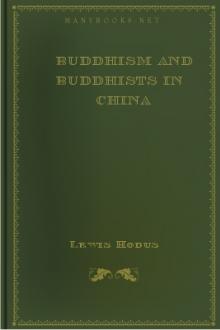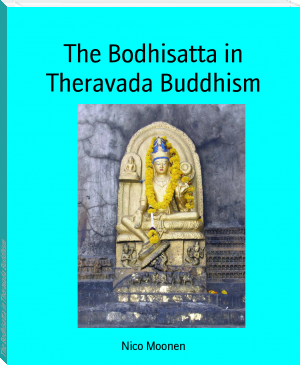Buddhism and Buddhists in China by Lewis Hodous (mystery books to read txt) 📖

- Author: Lewis Hodous
- Performer: -
Book online «Buddhism and Buddhists in China by Lewis Hodous (mystery books to read txt) 📖». Author Lewis Hodous
4. Monasteries Are Supported Because They Control F�ng-shui
The prayers for rain are an important part of the Chinese peasant’s world order. Drought is the manifestation of Heaven’s displeasure at the infraction of Heaven’s laws. It calls for self-examination and repentance. Thus the monastery opens up the windows of the universal order as this touches the humble tiller of the soil.
The Buddhist monasteries not only hold services in time of drought, but also in time of flood and at times when plagues of grasshoppers afflict the land, or when diseases afflict human beings. Their adoption of Chinese customs led them to have special ceremonies at the eclipse of the sun and moon, although they knew the cause of the eclipse. Peasants and officials support the monastery because of these services regulating the wind and water influences and through them bringing the people into harmonious relation with the great world of spirits.
BUDDHISM AND THE FAMILY
One of the criticisms of the Chinese against Buddhism is that it is opposed to filial piety. According to Mencius the greatest unfilial act is to leave no progeny. In spite of this charge Buddhism has done much for the family. It has taken over the ethics of the family, filial piety, obedience and respect for elders, and has made them a part of its system. Transgression of these fundamental duties is visited by dire punishments in the next world. The faithful observance is followed not only by the rewards of the Confucian system, but results in the greatest rewards in the future life.
1. Kuan Yin, the Giver of Children and Protector of Women
Buddhism has done more. Out of its atmosphere of love and mercy toward all beings has developed Kuan Yin, the ideal of Chinese womanhood, the goddess of Mercy, who embodies the Chinese ideal of beauty, filial piety and compassion toward the weak and suffering. She is especially the goddess of women, being interested in all their affairs. Her image is found in almost every household and her temples have a place in every part of China.
A brief history of this deity will enable us to understand the significance of the cult. Kuan Yin started as a male god in India, called Aval�kit�svara, who was worshipped from the third to the seventh century of our era. He was the protector of sailors and people in danger. In the course of time, either in China or in India, the god became a goddess. Some think that this was due to the influence of Christianity. In China both forms survive, though the goddess is better known. A Buddhist once said that a Bodhisattva is neither male nor female and appears in whatever form is convenient.
Kuan Yin is a very popular goddess. Her experiences in Hades are dramatically presented by traveling theatrical companies. Her deeds of mercy are portrayed in art. Her well known story runs as follows:
Kuan Yin was the daughter of the ruler of a prosperous kingdom located somewhere near the island of Sumatra. Her birth was announced to the queen by a dream. The little girl ate no meat nor milk. Her disposition was very good. Her intelligence was most extraordinary. Once she read anything she never forgot it.
At the age of sixteen her father tried to betroth her to a young prince. She refused and decided to give herself to a life of fasting and abstinence. Angered b-v her obstinacy the father ordered her to take off her court dress and jewels, to put on the garb of a servant and to carry water for the garden. The garden never looked so beautiful. The daughter also looked well and showed no signs of weariness, because the gods assisted her in her work.
Relenting a little the king sent an older sister to urge Kuan Yin to accept the husband he had found for her. When she refused, he sent her to a monastery and charged the abbess to treat her harshly, so that she might be forced to return home. Expecting to win the king’s favor, the abbess put the most unpleasant tasks on the girl. But again the gods assisted her and made her work light, so that her tasks were always well done and the young woman was cheerful.
One day the report came to the king that his daughter was associating with a young monk discussing heterodox doctrines and that she had given birth to a child. This news so enraged the king that he burned the monastery, killing many monks. The princess was captured and brought before him. Inasmuch as she was obdurate, the king ordered her to be executed. The executioner’s sword, however, broke into a thousand pieces without doing her any injury. The king then ordered her to be strangled. A golden image sixteen feet high appeared on the spot. The princess laughed and cried: “Where there was no image, an image appeared. I see the real form. When body flesh is strangled, then appear the lights of ten thousand roads.” She went to purgatory and purgatory at once changed into paradise. Yama, in order to save his purgatory, sent her back to the world. She appeared at Puto, an island off the coast of Chekiang near Ningpo. Here she rescued sailors and performed many miracles for people in distress.
In the meantime the father, who had committed many sins, became sick. His allotted time of life had been shortened by twenty years. Moreover, an ulcer grew on his body for every one of the five hundred monks he had killed when he burned the monastery. A miserable, loathsome old man, he came to an old monk, who was really the princess in disguise, and asked for help. The monk told him that an eye and an arm of a blood relative made into medicine was the only cure for his trouble. The two living daughters were willing to make such an offering, but their husbands would not permit them to do so. The old monk urged the monarch to take up a life of abstinence, to rebuild the monastery he had burned, and to provide money for services to take the five hundred monks whom he had killed through purgatory. He also said that a nun in the convent would offer an arm and an eye. When the monarch entered the monastery, he found hanging before the incense burner an arm and an eye. These were boiled, mixed with medicine and rubbed on the king’s body. He soon became well. Further inquiry revealed that these members belonged to his daughter.
This is the story of the most popular goddess in China. She is worshipped by her devotees on the first and fifteenth of every month, on the nineteenth of the sixth month, when she became a Bodhisattva, and on the nineteenth of the ninth month, when she put on the necklace. A month after marriage every young bride is presented with an image of the Goddess of Mercy, an incense-burner and candlesticks.
This goddess is worshipped whenever trouble comes to man or woman. Her names signify her willingness to listen to all prayers. She is the “one who regards the voice,” i.e., prayer; “one who hears the prayers of the world;” “one who regards and exists by himself as sovereign;” “the ancestor of Buddha who regards prayer;” “one who frees from fear;” “Buddha the august king;” “the great white robed scholar;” “great compassion and mercy.”
2. Kuan Yin, the Model of Local Mother-GoddessesThis conception is the creation of the social and religious consciousness of the women in China. It reveals their aspirations for mercy, compassion, filial piety and for the beauty that crowns a well developed character. Such an ideal does not mean that these have been realized in all the numerous homes of the Chinese, but it manifests their sense of such an ideal to be realized in life and their ardent longing for its realization.
Mother-goddesses are found all over China and they have all of them been influenced by Kuan Yin. Some of them have originated with actual women who were deified after death. Here is the story of one of these goddesses who presides over the censer in a small temple in Formosa. She was born in the province of Kuangtung. At the age of seven she was adopted by a family as the future wife of their eighteen-year-old son. One day while crossing a river he was drowned. This was a great blow to her. When she was fourteen years old the father of the family died. The two women, thus left alone, wept bitterly day and night. The comfort of relatives was of little avail. The mother was becoming emaciated with grief. The daughter, unable to bear the strain any longer, washed herself, burned incense before the ancestral tablet of her betrothed, and then took this vow:
“I am willing to remain a virgin, to apply myself to carrying water and working at the mortar and to serve my mother-in-law. If I cherish any other purpose and change my chastity and obedience, may Heaven slay me and earth annihilate me.”
When the mother heard this vow she stopped her weeping. Inasmuch as they had no uncle to look after them, they worked day and night. A relative of her future husband gave her one of his sons as an adopted son. The child died after a few months. This was a great grief. Then the mother died. The daughter sold her possessions to obtain money for a proper burial. She had only a coarse mourning cloth for her dress. After a while she adopted a child as her son. When he grew up she found him a wife who served her as faithfully as she had served her mother-in-law. When she was eighty years old, she dreamed that the golden maid and jade messenger of Kuan Yin stood beside her saying: “The court of Heaven has ordered you to become a god (sh�n).” She died soon after this. She said of herself:
“Shang Ti took compassion upon me during my life, because with a firm heart I kept my chastity and served my mother-in-law with complete obedience. Therefore he gave me the office of Kuan Pin. I have performed my duties in several places. Now I am transferred to Formosa.”
This story and many others like it mirror the moral ideals of the women of China in the midst of their struggles for help and light and guidance.
3. Exhortations on Family VirtuesThe Buddhists issue a large number of tracts. These are very commonly paid for by devotees who make a vow that, if their parent becomes well, they will pay for the printing of several hundred or thousand of these tracts for free distribution. In these tracts are usually many stories illustrating the rewards of filial piety. The story is told in one of them about a Mrs. Chin whose father-in-law being ill was unable to sleep for sixty days. His condition grew worse. Mrs. Chin knelt before Kuan Yin’s altar, cut out a piece of flesh from her arm and cooked it with the father’s food. His health at once improved and he lived to the age of seventy-seven. Another story is told in the same tract of a woman who cut out a piece of her liver and gave it as medicine to her mother-in-law.
These Buddhist tracts take up all the moral habits which make the family and clan strong and stable and surround them by the highest sanctions. A tract picked up in a Buddhist temple at Hangchow purports to be





Comments (0)